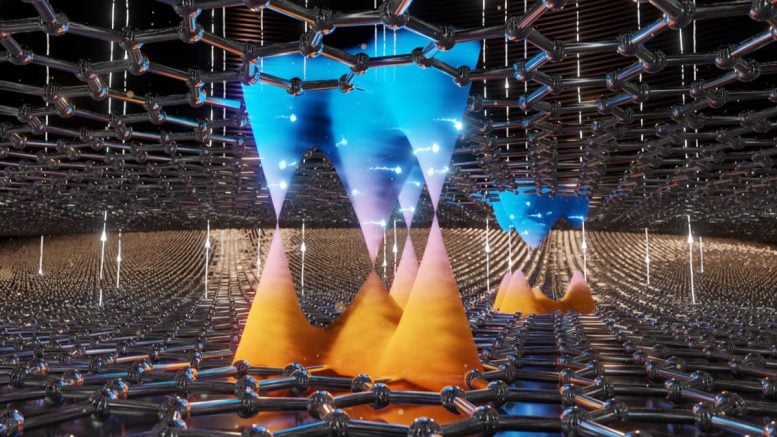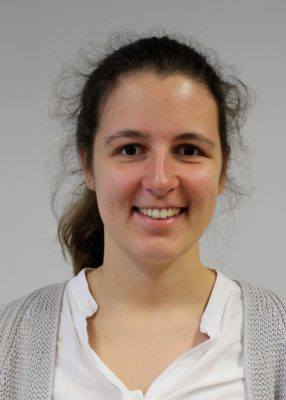

Artist’s representation of moving charges in naturally occurring bilayer graphene. Credit: Lukas Kroll
Researchers have shown that double-layer graphene can function both as a superconductor and an insulator, a property that could revolutionize transistor technology. This dual functionality allows for the development of nanoscale transistors that are highly energy-efficient.
An international research team led by the University of Göttingen has demonstrated experimentally that electrons in naturally occurring double-layer graphene move like particles without any mass, in the same way that light travels. Furthermore, they have shown that the current can be “switched” on and off, which has potential for developing tiny, energy-efficient transistors – like the light switch in your house but at a nanoscale. The Massachusetts Institute of Technology (MIT), USA, and the National Institute for Materials Science (NIMS), Japan, were also involved in the research. The results were published in the scientific journal Nature Communications.
Properties and Challenges of Graphene
Graphene was identified in 2004 and is a single layer of carbon atoms. Among its many unusual properties, graphene is known for its extraordinarily high electrical conductivity due to the high and constant velocity of electrons traveling through this material. This unique feature has made scientists dream of using graphene for much faster and more energy-efficient transistors.
The challenge has been that to make a transistor, the material needs to be controlled to have a highly insulating state in addition to its highly conductive state. In graphene, however, such a “switch” in the speed of the carrier cannot be easily achieved. In fact, graphene usually has no insulating state, which has limited graphene’s potential as a transistor.
Breakthrough in Graphene Transistor Research
The Göttingen University team has now found that two graphene layers, as found in the naturally occurring form of double-layer graphene, combine the best of both worlds: a structure that supports the amazingly fast motion of electrons moving like light as if they had no mass, in addition to an insulating state.
The researchers showed that this condition can be changed by the application of an electric field applied perpendicularly to the material, making the double-layer graphene insulating.
This property of fast-moving electrons had been theoretically predicted as early as 2009, but it took significantly enhanced sample quality as enabled by materials supplied by NIMS and close collaboration about theory with MIT, before it was possible to identify this experimentally. While these experiments were carried out at cryogenic temperatures – at around 273° below freezing – they show the potential of bilayer graphene to make highly efficient transistors.
“We were already aware of the theory. However, now we have carried out experiments that actually show the light-like dispersion of electrons in bilayer graphene. It was a very exciting moment for the entire team,” says Professor Thomas Weitz, at Göttingen University’s Faculty of Physics.
Dr. Anna Seiler, Postdoctoral researcher and first author also at Göttingen University, adds: “Our work is very much a first step but a crucial one. The next step for researchers will be to see if bilayer graphene really can improve transistors or to investigate the potential of this effect in other areas of technology.”
Reference: “Probing the tunable multi-cone band structure in Bernal bilayer graphene” by Anna M. Seiler, Nils Jacobsen, Martin Statz, Noelia Fernandez, Francesca Falorsi, Kenji Watanabe, Takashi Taniguchi, Zhiyu Dong, Leonid S. Levitov and R. Thomas Weitz, 11 April 2024, Nature Communications.
DOI: 10.1038/s41467-024-47342-0


